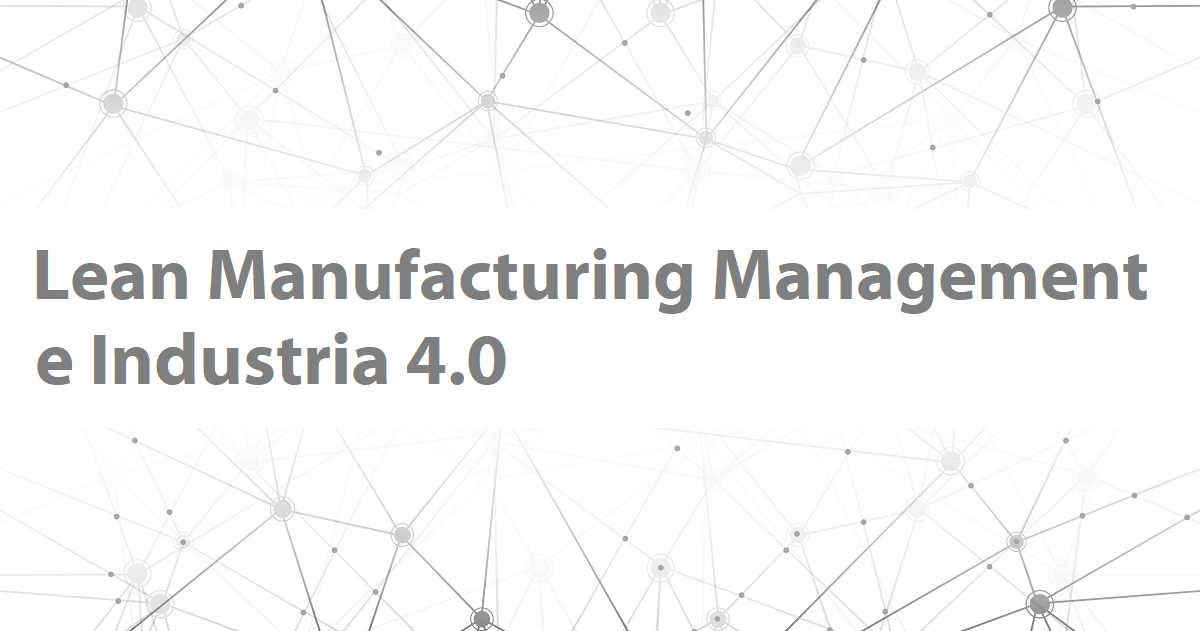Lean process in Industry 4.0: optimising waste in digitising enterprises
For years, there has been talk of Industry 4.0 and lean processes in manufacturing with the aim of streamlining the complexity of operations with simpler, less complex methods and having systems that are much more ready to respond to the times of an increasingly fast-paced and frenetic market. Of course, many of these processes have also been digitised to be managed through the use of handheld terminals or portable PCs.

Industry 4.0, which aims to digitise production and logistics systems, is coming to the aid of Lean Manufacturing by adding new functions that help reduce waste.
These are undoubtedly two phenomena that arrived at different times and with different goals. For example, Lean Manufacturing aims to reduce waste (the famous 9 MUDA) while Industry 4.0 focuses on data acquisition to better manage processes. In both cases, it is a matter of re-engineering activities within the company with the aim of optimisation.
Looking specifically at the scope of the applications proposed by Sygest, we could say that the “Packing List Photo” and “IUNGO” are in fact two examples of Lean Manufacturing Management processes that come under Industry 4.0 because they aim at improving logistics-related areas.
Packing List Photo: a Lean Manufacturing Management System
Packing List Photo streamlines the process of creating a Packing List, reduces shipping errors by 99%, and makes the data available directly in the Cloud so that Customs or the end customer can already see the contents of the package with photos of the components via a QR code on the package itself.
Thanks to Lean Manufacturing Management procedures, all this translates into much faster transfer times (no hiccups at customs), the certainty of a correct shipment, and the assurance, to the end customer, that the part has left in optimal condition (without problems).
When preparing the packing list, photos are only taken when needed, without the need to photograph everything in advance (even the unnecessary), so the photo archive is gradually filled in an absolutely ‘Lean’ concept.
If a photo has already been taken in another shipment, thanks to the logic of Lean Manufacturing, it is no longer required unless a specific photo of that shipment is to be taken. The acquisition of weights and dimensions also follows the same logic, i.e. they are only requested if they are missing from the data coming from the ERP to which they then ‘return’ to be available the next time.
As a further advantage, checks are cascaded after picking, correctly separating the picking and shipping phases, ensuring that only the correct parts are shipped and nothing is missing from the packaging before departure.
IUNGO: the Lean Supply Chain Management system
Another very important application for Lean Logistics, and also for Industry 4.0, is IUNGO, the Lean Supply Chain Management system that eliminates waste from both the purchasing department of the customer company and the supplier. IUNGO was born from a very innovative idea ahead of its time, i.e. using a traditional e-mail to integrate customers and suppliers in the management of orders and deliveries.
IUNGO is known as a supplier order integration tool, although in reality great advantages can be had in the management of ‘prebills’ and goods origin documentation.
With the ‘prebills’, the supplier prepares the shipping document for use by IUNGO so that when the goods arrive from the customer, the material is automatically loaded into the warehouse. The supplier can also apply the material identification labels (with bar codes) according to the customer’s criteria and in complete Lean Manufacturing optics, so that on receipt he finds the components already labelled according to his own rules and avoiding “unnecessary” time losses.
The goods origin document also integrates the goods origin information of the purchased materials within the goods dispatch document so that it can then be acquired by the ERP via an appropriate interface and without any manual activity, all thanks to Lean Manufacturing Management practices.
The advantage is that the information on the origin of the goods arrives in a timely manner from the supplier together with the material without having to search for it at the moment of need, which is when the Packing List Photo is prepared, where it becomes essential to have this data to show (or print).
As we can see, therefore, the digitisation of processes, of which Industry 4.0 summarises the paradigm, works in the logic of connecting even “very distant” business activities with “Lean” concepts, removing unnecessary work from operators and drastically reducing working time.
